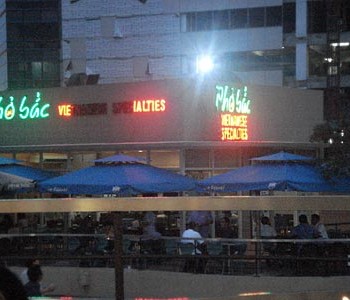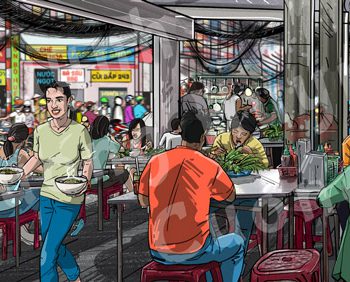Updated 04-02-18. I was recently contacted by a restaurateur to help her pho restaurant. Without taking immediate action to improve business, this pho restaurant will have to close because revenues are not enough to cover expenses.
All the signs are there. Quite clear actually. Even casual observers can probably see what's wrong with this pho restaurant. For various reasons, though, it's never clear to the owner.
Unfortunately, with all my knowledge about pho, about pho business, and about how to properly run a pho restaurant, I couldn't help the owner.
This is the story of a failing pho restaurant that I tried but could not help. The restaurant has lots of potentials and is in decent location, but sadly it's probably not going to make it.
 Initial Consultation and Observation
Initial Consultation and Observation
I normally have some idea why a pho restaurant may be failing upon initial examination. However, I don't jump to quick conclusions. I always go through the consultation and analysis process to make sure all information, data and facts are collected and understood. So what are some initial signs of failures? Here are some:
- The restaurant ran a 20% off grand-opening special that lasted for 2 months. When she finally stopped doing the special, the customers were used to paying the low prices, didn't like the increased prices, and all left.
- The owner thinks her pho is rated 8-9 out of 10, yet the dining room is always empty.
- This pho restaurant charges 10-20% more compared to many pho restaurants within 3-4 blocks.
- The menu has numerous items, too confusing for first time visitors and more than half the items don't sell regularly.
- The restaurant name, ambiance and service are neither welcoming nor inviting.
- The owner does not know how much labor or food costs her restaurant is incurring.
This was just the start. There were many more issues that surfaced upon further examination.
Symptoms of a Poorly Run Pho Restaurant
It's not like the owner did not know what was wrong with her restaurant. Of course she had to know. All the symptoms were there, very clear. In any case, I tried to help her see them and take proper action to rectify.
- The 20% off grand-opening special lasted for 2 months. Right after it ended, business dropped drastically.
- The kitchen is unorganized, inventory not done regularly, and signs of cross contamination abound.
- The staff seems competent, but the leadership is lacking. Her husband who has a full-time job elsewhere, helps in the evening and weekends. This by itself is not necessarily a problem. The problem is he does whatever he feels like, in his own way, when he's there.
- The owner makes less than good basic business decisions. An example is staying open past 10PM so they can serve one or two "regular" customers a few times a week.
- Aside from a Facebook page that really does nothing and a Yelp page with one review, there is not much marketing or online activity going on.
When I dug a little further into the operation, there were other additional reasons for this pho restaurant to not make it, and the owner agreed that immediate action had to be taken to save it.
Treatment For the Illness
I immediately set out to work to help this pho restaurant turn around. First order of business involved fixes in multiple areas, including getting organized; learning the basics of restaurant numbers; understanding the food quality, food cost, customer service and staff training problems; then creating a plan and following through with it. At every step of the way, I worked closely with the owner to help her understand all issues involved, understand how to carry out the fixes and their impact on saving her business.
- One of the most important things to do first is to properly use the POS (point of sale) system. No, not to take order, collect money and give changes. I'm talking about knowing what the program does, how it collects information, how to analyze the stored data and then use the resulting sales figures to improve operation.
- Review all aspects of the menu, including design, menu items (how they are prepared and served), how they are priced, prioritization of what should be and not be on the menu, etc.
- Consider online and traditional marketing methods to start connecting with potential customers, get important online presence, build trust in existing customers, and attract new ones.
- Create a plan to makeover the brand. This includes making the dining room a comfortable place for diners to want to come and enjoy their meals with friends and families, training the staff to be more knowledgeable in customer service and in the restaurant's own dishes and ingredients.
These are just a few of the things identified in the plan to fix this ailing restaurant. I created a detailed schedule of tasks, serving as the roadmap for the owner to follow. For each area, I spend plenty of time walking her through best practices and detail on how they will help turn the pho restaurant around. The schedule called for 4-5 weeks of preparation and a few days to a week to make any physical changes and re-open.
The Real Hindrance
While there are other additional shortfalls that this pho restaurant displays, after 2 weeks of work, it was clear that there is only one thing that really matters. This is the one thing I've known all along, have initially discussed it with the owner, and have hoped that it would not be the case for this rescue project. I knew that if the owner can solve this one problem, then her pho restaurant may survive.
- The existing operation needs changes in many key areas, and it needs total commitment from the owner to make those changes.
- Only the owner can make the final decision to willingly change herself to become a better business person. She has to want to change the status quo and get out of the current situation before she can even think about making any profit.
- Unfortunately, the owner didn't seem to be motivated enough to carry out the changes. There seems to be one reason or another (more like excuses) why certain thing can't be done or why information critical to making decision is not available.
After 2 weeks of what seemed like smooth sailing toward fixing the restaurant's problems, the owner told me she understood all the reasons for following through with the plan, but insisted that the fixes to be done more quickly and without having to go through the work involved.
What? Quick fixes without having to do the work? Unbelievable!
The Bottom Line
So that's how far the project went. I could not help this pho restaurant if the owner doesn't really want to make the necessary changes. This is not a case of quick fix, two-day makeover, or simple cosmetic change. The reality is the owner and her restaurant must go through changes at the foundation of the business, and change her way of doing business.
The sad fact is, no pho restaurant ever fails all of a sudden. Either it didn't start out right to begin with, or it's a very gradual slide to the abyss of inconsistent food quality, bad customer reviews, and eventually no revenue. In almost all cases, there's always time to make corrective action if the owner wants to do it. But in the vast majority of cases, you can watch, as if in slow motion, a pho restaurant going down and down, and eventually close.
So there it is. I hope this story helps someone avoid making the same mistakes.
Do you have a story to tell about a failing restaurant? Or maybe a successful restaurant? Share with us in the comments below.
For help with your pho restaurant, book a one-hour pho restaurant consultation and get your questions answered.



